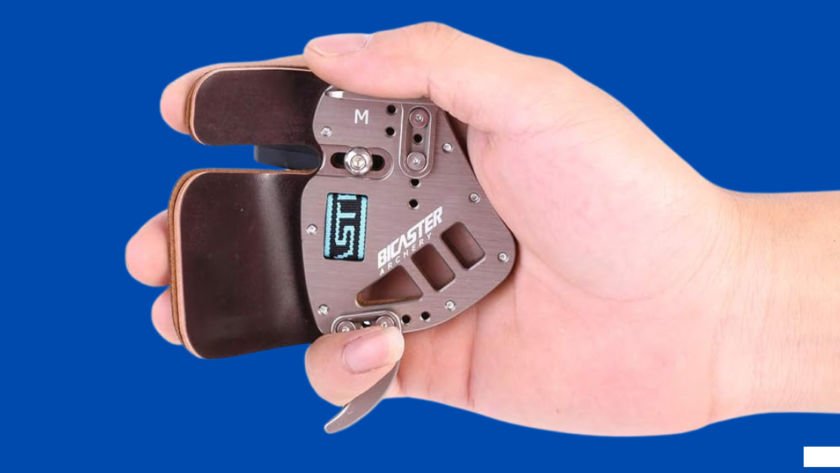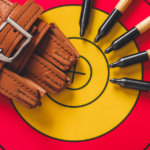As an archer, I’ve come to appreciate the subtle nuances that can make or break a shot. One piece of equipment that often flies under the radar but plays a crucial role in accuracy is the finger tab.
When I first picked up a bow, I naively thought finger tabs were just simple leather patches to protect my fingers.
Boy, was I wrong!
Whether you’re new to archery or a seasoned pro looking to fine-tune your gear, this close look into archery finger tabs will equip you with valuable insights.
We’ll explore everything from material choices to customization options, helping you make informed decisions about this essential piece of equipment.
The Anatomy of a Finger Tab
A finger tab is much more than a basic protective device for your drawing hand. Modern tabs are sophisticated pieces of gear designed to enhance your shooting experience.
Let’s break down the key components:
Face Material
The face material is the part that contacts the bowstring. Traditionally, leather has been the go-to choice, with cordovan leather being particularly prized for it’s durability and smooth release.
However, synthetic materials are gaining popularity for their consistency and weather resistance.
Leather offers a classic feel and molds to your fingers over time, creating a personalized fit. It’s excellent for archers who appreciate a natural material and don’t mind a break-in period.
On the other hand, synthetic materials like SuperLeather or CarbonX provide consistent performance regardless of weather conditions and need little to no break-in time.
Backing Material
The backing is what touches your fingers. It’s typically made of a softer material like suede or felt to provide comfort during long shooting sessions.
Some high-end tabs feature memory foam or gel inserts for added comfort.
The choice of backing material can significantly impact your shooting experience. A comfortable backing allows you to focus on your form and technique without distraction.
Some archers prefer a thicker backing for added cushioning, while others opt for a thinner backing for increased sensitivity.
Spacer
Many tabs include a spacer that sits between your index and middle fingers. This small but mighty component helps prevent pinching and promotes a cleaner release.
Spacers come in various shapes and sizes, allowing you to customize the fit to your hand.
A well-fitted spacer can improve your release consistency by ensuring your fingers are positioned the same way for each shot. Some archers even experiment with different spacer materials or shapes to fine-tune their release.
Platform or Shelf
Some tabs feature a platform or shelf that extends beyond the fingertips. This can help with consistent finger placement and provide a reference point for anchoring.
The shelf is particularly popular among Olympic recurve and barebow archers who use it as part of their aiming system.
The size and shape of the platform can vary significantly between different tab models. Some archers prefer a minimal shelf for a cleaner feel, while others opt for a larger platform that offers more stability and reference points.
Hair Plate
A somewhat controversial addition, the hair plate is a small patch of material (often actual hair or a synthetic equivalent) placed on the face of the tab. It’s designed to reduce friction during release, but it’s effectiveness is debated among archers.
Proponents of the hair plate claim it provides a smoother release and reduces string noise. Skeptics argue that it’s unnecessary and can even interfere with a clean release if not properly maintained.
Ultimately, the decision to use a hair plate comes down to personal preference and shooting style.
Choosing the Right Finger Tab
Selecting the perfect finger tab is a highly personal process. Here are some factors to consider:
Material Matters
The choice between leather and synthetic materials is often the first decision you’ll make. Leather offers a traditional feel and molds to your fingers over time, while synthetics provide consistent performance in various weather conditions.
If you opt for leather, be prepared for a break-in period. The tab will become more comfortable and perform better as it conforms to your hand.
Synthetic materials, on the other hand, offer consistent performance right out of the box but may lack the personalized feel of a well-worn leather tab.
Thickness and Layering
Tabs come in various thicknesses and may have many layers. Thicker tabs offer more protection but can reduce string feel.
Experiment with different options to find the right balance for your shooting style.
Some archers prefer a thinner tab for increased sensitivity, while others opt for a thicker tab for added protection during long shooting sessions.
Multi-layered tabs allow you to adjust the thickness by adding or removing layers, providing a customizable experience.
Size and Fit
A properly sized tab is crucial for comfort and performance. Most manufacturers offer sizing guides, but it’s best to try different sizes if possible.
The tab should cover your fingertips without extending too far beyond them.
When fitting a tab, pay attention to how it sits on your hand. It should feel secure without being overly tight or restrictive.
The spacer should fit comfortably between your fingers, and the platform (if present) should align naturally with your hand position.
Additional Features
Consider whether you want a tab with a shelf, spacer, or other features. These can enhance your shooting experience but may also need some adjustment to your technique.
Some tabs come with adjustable finger spacers, allowing you to fine-tune the fit. Others may have interchangeable face materials or backing options.
While these features can be useful, they can also add complexity to your setup.
Consider your skill level and shooting goals when deciding on extra features.
Breaking In Your New Tab
Once you’ve selected your tab, it’s time to break it in. This process is especially important for leather tabs:
- Wear the tab around the house to start softening the material.
This helps the leather begin to conform to your hand shape.
- Bend and flex the tab to make it more pliable.
Gently work the material, focusing on areas that feel stiff or uncomfortable.
- Use leather conditioner sparingly to soften the material without oversaturating it.
A small amount of conditioner can help speed up the break-in process without compromising the tab’s integrity.
- Shoot with the tab, gradually increasing your session length to allow your fingers to adjust.
Start with shorter sessions and pay attention to how the tab feels as you use it.
Remember, a new tab may feel awkward at first, but with patience, it will become an extension of your hand. The break-in process can take anywhere from a few hundred shots to several thousand, depending on the material and your shooting frequency.
Advanced Customization Techniques
For those looking to take their tab game to the next level, consider these customization options:
Face Material Texturing
Some archers prefer to add texture to their tab face for a more consistent release. This can be done by lightly sanding the surface or using specialized texturing tools.
The goal is to create a slightly rougher surface that grips the string more consistently.
Be cautious when texturing your tab face, as too much roughness can actually hinder your release. Start with a very fine grit sandpaper and test frequently to find the right balance.
Backing Material Replacement
If you find the stock backing uncomfortable, you can replace it with a material that suits your preferences. Some archers swear by memory foam or gel inserts for added comfort.
To replace the backing, carefully remove the existing material and cut a new piece to fit. Experiment with different thicknesses and materials to find what works best for you.
Some archers even use many layers of different materials to create a custom feel.
DIY Spacers
While many tabs come with built-in spacers, you can create custom spacers using materials like leather or foam to achieve the perfect fit between your fingers.
To make a custom spacer, start by tracing the shape of your existing spacer onto your chosen material. Cut it out and test the fit, adjusting as necessary.
You can even create spacers of different thicknesses to fine-tune your finger position.
Modifying the Platform
For tabs with platforms or shelves, you can customize the shape and size to better suit your shooting style. Some archers trim down the platform for a more minimal feel, while others extend it for extra reference points.
When modifying the platform, make small changes and test thoroughly before making further adjustments. Remember that significant modifications may affect the tab’s overall balance and feel.
Common Pitfalls and How to Avoid Them
Even experienced archers can fall into these traps:
Overtightening the Tab
Securing your tab too tightly can restrict blood flow and reduce sensitivity. Ensure your tab is snug but not constricting.
You should be able to wiggle your fingers slightly within the tab without it feeling loose.
Pay attention to any numbness or tingling in your fingers during long shooting sessions. If you experience these symptoms, loosen the tab or consider a different size or style.
Neglecting Maintenance
Clean your tab regularly and replace it when it shows signs of wear to maintain consistent performance. For leather tabs, occasional conditioning can help prolong their life and maintain their suppleness.
Inspect your tab before each shooting session, looking for signs of wear or damage. Pay particular attention to the face material and any stitching or attachment points.
Ignoring Changes in Technique
As your tab breaks in, your release may change slightly. Be prepared to make minor adjustments to your form.
This might include tweaking your anchor point or adjusting your finger placement on the string.
Keep a shooting journal to track any changes in your technique or tab performance. This can help you identify patterns and make informed adjustments over time.
Switching Tabs Too Often
While it’s good to experiment, constantly changing tabs can hinder the development of muscle memory. Once you find a tab that works well for you, stick with it for a while to allow your technique to stabilize.
If you do decide to try a new tab, give yourself lots of time to adjust before making a final decision. It can take several weeks of consistent shooting to fully adapt to a new tab.
Adapting Your Tab to Different Archery Disciplines
Your choice of tab may vary depending on your archery discipline:
Olympic Recurve
Precision is paramount in Olympic recurve archery. Tabs with shelves and hair plates are popular for their consistency and smooth release.
Many Olympic recurve archers opt for tabs with larger platforms to help with their aiming and anchoring process.
The shelf on an Olympic recurve tab often serves as a reference point for consistent hand placement and can be used in conjunction with other sighting methods.
Some archers even mark their shelves with small indicators to fine-tune their aiming.
Traditional Archery
Many traditional archers prefer simpler tabs without extra features to maintain a more authentic shooting experience. Leather tabs are particularly popular in this discipline for their classic look and feel.
Traditional archers often focus on the tactile sensation of the string, so thinner tabs or those with minimal backing are common choices. Some traditional archers even make their own tabs using historical materials and techniques.
Barebow
Barebow archers often use tabs with prominent shelves that can double as a reference point for string walking techniques. The shelf becomes an integral part of the aiming system in barebow archery.
Barebow tabs may feature markings or cutouts on the shelf to help with precise string placement for different distances.
Some barebow archers customize their tabs with extra reference points or textures to enhance their string walking technique.
Exercises to Improve Your Tab Technique
Mastering your finger tab technique can significantly improve your shooting consistency. Here are some exercises to help you refine your skills:
Blind Release Practice
Close your eyes and focus on the feeling of a clean release through your tab. This exercise helps you develop a better sense of touch and consistency in your release.
Start by drawing your bow to anchor with your eyes open, then close them before releasing. Pay attention to the sensation of the string sliding off your fingers and the overall feel of the release.
Repeat this exercise for 10-15 shots, focusing on maintaining a consistent feel with each release.
Slow-Motion Shooting
Perform your draw and release in slow motion to identify any inconsistencies in your tab usage. This exercise allows you to focus on each aspect of your shot process and how your tab interacts with the string.
Begin by drawing your bow at about 25% of your normal speed. Pay close attention to how the string feels against your tab as you draw. Release the string just as slowly, noting how it rolls off your fingers.
This exercise can help you identify any hitches or inconsistencies in your release that might be masked at full speed.
Tab Pressure Drills
Experiment with different finger pressures on the tab to find your optimal grip. This exercise helps you understand how varying pressure affects your release and overall shot consistency.
Start with your normal draw and release, paying attention to the pressure you typically use. Then, try a series of shots with slightly more pressure, followed by a series with slightly less pressure.
Note how these changes affect your release and arrow flight.
The goal is to find the sweet spot that provides the cleanest, most consistent release.
String Walking Practice
For barebow archers, practice precise tab placement for different distances. This exercise helps you develop a more accurate and consistent string walking technique.
Set up targets at various distances, starting with shorter ranges and progressing to longer ones. For each distance, focus on placing your fingers on the string at the exact same point on your tab.
Use the markings or features on your tab’s shelf as reference points.
With practice, you’ll develop a better feel for how small changes in finger placement affect your arrow’s impact point.
Frequently Asked Questions
What is a finger tab in archery?
A finger tab is a protective device worn on the drawing hand to shield the fingers from the bowstring. It also helps provide a smoother release, improving accuracy and consistency in shooting.
Are finger tabs necessary for archery?
While not strictly necessary, finger tabs are highly recommended for most archers. They protect your fingers from the repeated stress of drawing and releasing the bowstring, which can lead to soreness, blisters, and nerve damage over time.
How do I choose the right size finger tab?
To choose the right size, measure from the tip of your middle finger to the base of your palm. Most manufacturers provide sizing charts based on this measurement.
The tab should cover your fingertips without extending too far beyond them.
Can I use a finger tab with a compound bow?
While finger tabs are primarily used with recurve and traditional bows, some compound bow archers who shoot with fingers (rather than a release aid) do use tabs. However, most compound bow archers prefer mechanical release aids.
How often should I replace my finger tab?
The lifespan of a finger tab varies depending on usage and care. Generally, you should inspect your tab regularly and consider replacing it when you notice significant wear on the face material or if it no longer provides adequate protection or a consistent release.
What’s the difference between a finger tab and a shooting glove?
A finger tab covers only the fingertips and palm side of the fingers, while a shooting glove covers the entire finger. Tabs generally offer more precise control and a cleaner release, while gloves provide more overall finger protection.
Can I make my own finger tab?
Yes, many archers make their own tabs. Common materials include leather for the face and backing, with optional spacers made from various materials.
However, homemade tabs may lack some of the advanced features found in commercial products.
How do I care for my leather finger tab?
Clean your leather tab regularly with a soft, dry cloth. Occasionally treat it with a small amount of leather conditioner to keep it supple.
Avoid getting it wet, and store it in a cool, dry place when not in use.
What’s the purpose of the hair plate on some finger tabs?
The hair plate is designed to reduce friction between the tab and the string, potentially providing a smoother release. However, it’s effectiveness is debated among archers, and many choose tabs without this feature.
Can using a finger tab improve my accuracy?
A properly fitted and used finger tab can indeed improve accuracy by providing a more consistent release. It reduces variations in friction between your fingers and the string, leading to more uniform arrow flight.
Key Takeaways
- Choose a tab that fits your hand and shooting style properly.
- Allow time for breaking in and adjusting to a new tab.
- Regular maintenance and timely replacement are crucial for consistent performance.
- Don’t be afraid to customize your tab to suit your needs.
- Your tab choice may evolve as you progress in your archery skills.



